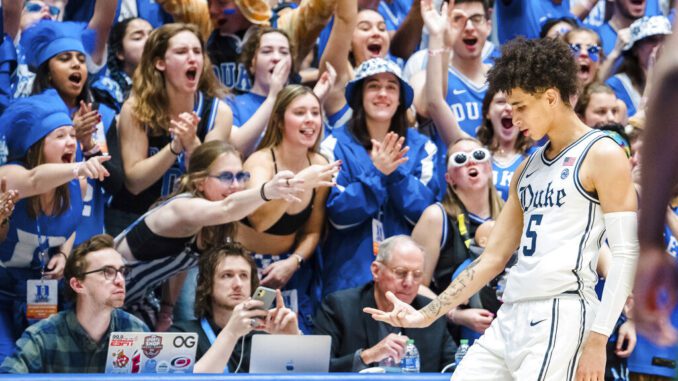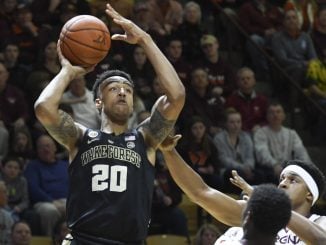
On Monday night, Duke’s attempt at a buzzer-beater to tie the score in Blacksburg resulted in a turnover, and the Blue Devils lost to Virginia Tech on the road. That’s not a shocking result. Duke is just 4-6 away from Cameron Indoor Stadium this season, although the Blue Devils are a perfect 10-0 at home.
Meanwhile, back in Durham, Maryland-Eastern Shore came back from 16 points down in the second half to beat NC Central on a last-second shot. That was a shocking result. The Eagles were a perfect 9-0 at home heading into the game, although they were 1-8 away from Durham.
The two games underscore a trend in college basketball this season. Not in recent memory has it been easier to root root root for the home team, because the home-court advantage is at a peak.

In North Carolina alone, there are three teams unbeaten at home: In addition to Duke, UNC is 10-0 at the Dean Dome this year, and UNC Asheville is 8-0 at home. Central’s loss on Monday knocked them from the ranks of the unbeaten on the home floor, and Wake Forest’s loss to Virginia last week was the first home loss for the Deacs.
Those five teams combined are 47-2 at home. And, while good teams can be expected to win at home, the same five teams are a combined 20-31 everywhere else.
All told, the state’s 19 Division I teams are a combined 131-45 at home for a .744 winning percentage. On the road and in neutral site games, they are 86-125, or .408. Both results are more polarized than last year when home teams in North Carolina went 193-75 (.720) while going 131-185 (.415) everywhere else.
Only two teams in the state have losing records at home. Elon is 2-6 (0-12 everywhere else), and Campbell is 4-5 (4-7 elsewhere).
Home teams in the entire ACC have a .758 winning percentage, 89 points higher than last year and the highest in seven seasons. In ACC conference games, home teams are winning at a .636 clip, 83 points higher than last season.
What are the reasons for the sudden surge by home teams? There are several different candidates.
Scheduling
Wake Forest coach Steve Forbes was shocked that his Demon Deacons didn’t get an NCAA bid last season despite going 25-10 and 13-7 in the conference. The reason? The schedule. Wake went 18-2 at home, feasting on beatable opponents, rather than playing a host of games against higher-rated opposition.
“We did upgrade our nonconference schedule,” he said. “Strategically, last year, we didn’t have a tough nonconference schedule because we had nine new players coming out of COVID. But visiting in the spring with the experts, there’s a lot of emphasis on November. You can agree with that or not. For me, personally, I think it’s more important to win on the road in the ACC than win in a casino or a ballroom in November.”
Forbes is apparently in the minority, however, and Wake added several power conference foes to the schedule, including LSU, Georgia, Wisconsin and Rutgers. Only one of those games was in Winston-Salem, however.
Because home teams tend to get dinged in the NCAA selection committee’s Quad system, many top teams opt to face off in neutral site games rather than scheduling home-and-home series, as they used to, so both teams can get the benefit of a boost in their opponent’s quad rating. However, that means the home schedule is dotted with small conference teams and expected blowouts, or, in the case of UNC, dark arenas. The Tar Heels opened with three mid-majors at home, then went 20 days and five games before playing at home again. The Heels had another 22-day home game drought in their schedule later in the season.
Home teams are pushing their toughest games off campus, which helps boost their home record.
Officiating
College basketball officiating has been, to put it nicely, inconsistent so far this season. And studies have shown that the home crowd has an impact on officiating decisions. With vocal capacity crowds at Cameron Indoor, the Dean Dome and a newly reinvigorated Joel Coliseum, it’s no surprise that Duke, UNC and Wake have gotten the benefit of the doubt at home.
It’s worked this year. At home, those three teams have scored an average of 17.9 points from the free-throw line to opponents’ 9.8. Wake, Carolina and Duke still have an advantage from the line on the road and neutral sites, but it is much eroded — They score 13.3 points per game from the line to opponents’ 12.6.
Those three teams have gotten 23.1 free throw attempts on average in home games to opponents’ 13.7. On the road and at neutral sites, it’s 18.6 attempts to 17.6.
It should come as no surprise that the fouls called also have the same split, with Duke, Carolina and Wake getting whistled for fouls 15.4 ties per game at home to opponents’ 19.8. While away from home, the calls are 17.4 to 17.9.
Duke coach Jon Scheyer has praised the fans at Cameron Indoor Stadium after multiple home games this season.
“What an amazing place to play basketball games,” he said after a recent home win over Miami. “Cameron is one of a kind. I think it showed today.”
There are plenty of teams around the country that have special places where they play their home games, and it’s showing this season more than ever.



